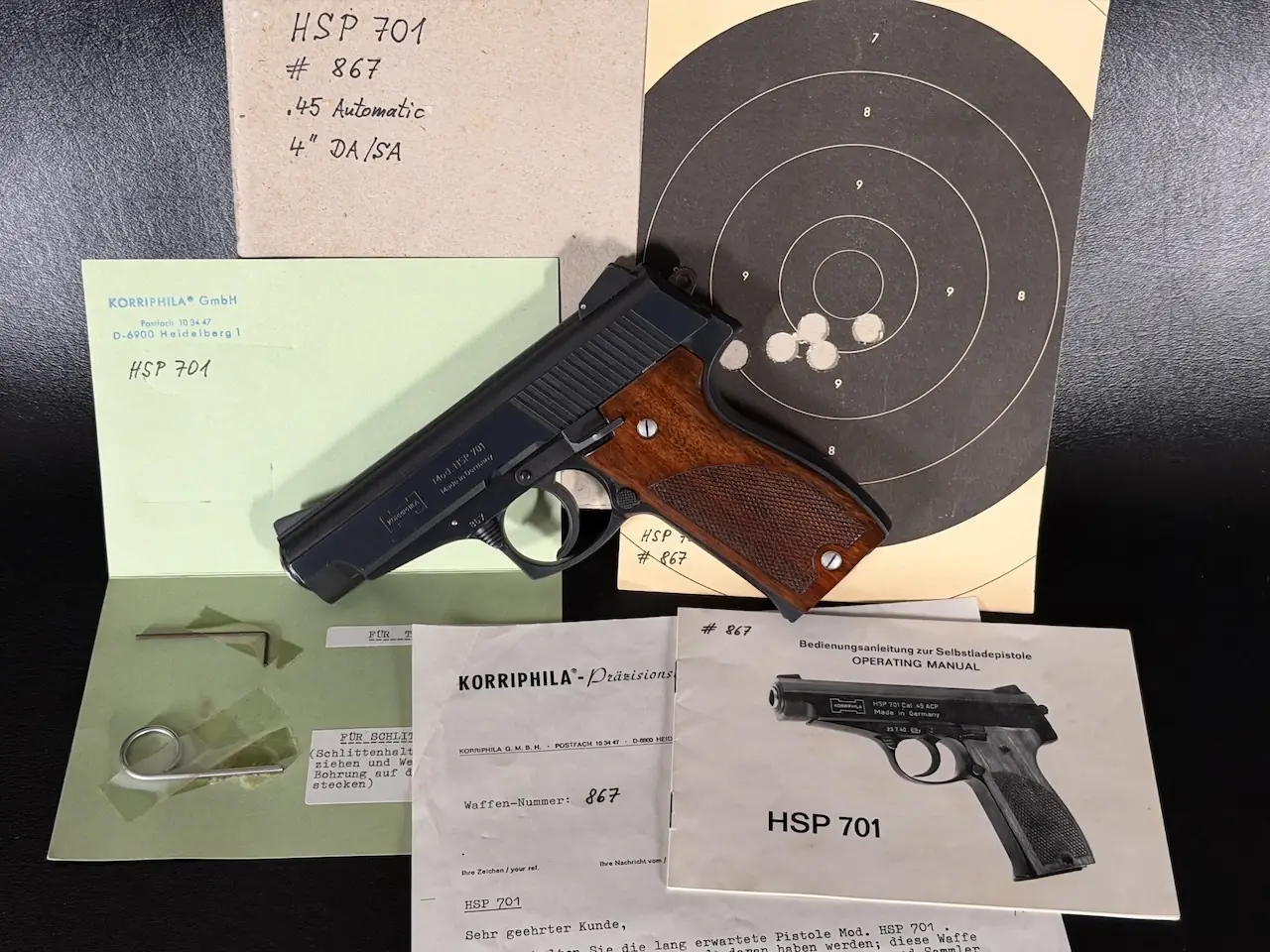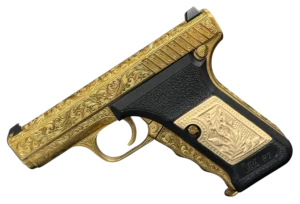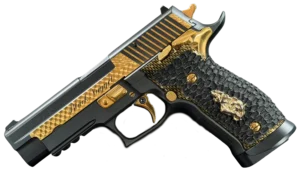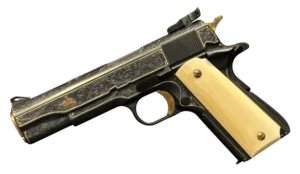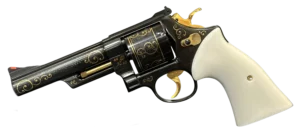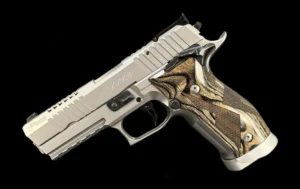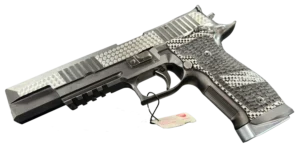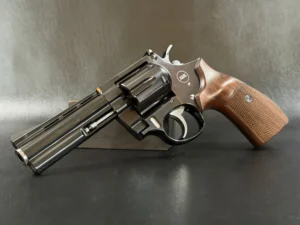Key Takeaways:
- Museum-grade firearms aren’t defined by shine but by story: A firearm reaches museum status when its history, originality, and cultural weight all line up. Condition matters, certainly, but the real magic comes from authenticity and the story that unfolds as the piece passes from one set of hands to another.
- Provenance can outweigh every other factor: You can have a flawless gun that still isn’t museum-worthy if its past is fuzzy. Clear provenance gives an object its voice. It anchors the firearm in time, links it to people or events, and turns it into something that teaches rather than just impresses.
- Rarity, originality, and artistry shape long-term value: Collectors and museums look for pieces that can’t be replaced. Whether it’s a one-of-one engraving, a prototype, or a historically carried sidearm, the combination of rarity and unaltered condition is what pushes a firearm from “collector grade” to “museum grade.”
Let’s get started…
There’s something strangely magnetic about a firearm that crosses that invisible line from “collectible” to “museum grade.” It’s the way people slow down when they see it. The way even seasoned collectors lean in a little closer, as if the steel itself is whispering something old and essential. Museum-grade firearms hold a gravity that other objects don’t. They tell stories that aren’t always written down, and sometimes you can feel those stories before you even understand them.
And while the term “museum grade” gets tossed around a lot, especially in private sales and high-end galleries, it actually means something. It’s not just a fancy label for a polished gun or a marketing flourish. Collectors, curators, and historians use this term carefully because so much hangs on it: value, legacy, cultural significance, even the way a piece fits into the broader story of craftsmanship and human design.
So yes, we’re talking about firearms. But in the same breath, we’re talking about art. Sculpture. Preservation. Memory.
Let’s walk through what truly defines a museum-grade firearm, why provenance carries almost as much weight as condition, and how elite collectors distinguish between “rare,” “collector grade,” and “investment grade.” And since our audience appreciates luxury art and sculpture, there will be moments where this overlaps with materials, artisanship, and the intangible beauty that fuels high-end collecting.
So What Exactly Counts as a Museum-Grade Firearm?
Here’s the thing: “museum grade” isn’t just a rating on a scale. It’s more like a consensus built from multiple layers. Condition, rarity, provenance, originality, cultural relevance, artistry, and sometimes even the maker’s philosophy all come together to decide whether a piece qualifies.
You could have a pristine pistol, polished to a brilliant shine, and still not achieve museum status. On the other hand, a well-worn service revolver can be absolutely museum-worthy if it has lived through the right history.
Museum-grade means the firearm stands as a primary source of cultural or technological significance. It’s an object that speaks for a moment in time.
Collectors tend to look for a few anchor traits:
- Untouched or exceptionally preserved condition
- Historical or cultural weight
- Complete originality of parts and finish
- High rarity or one-of-a-kind characteristics
- Documented provenance
The last one, provenance, sometimes outweighs everything else. A gun that sat on the desk of a U.S. general or was engraved by a royal workshop can still be considered museum-grade, even if it shows honest wear.
This is where the worlds of luxury firearms and high art overlap. Museums aren’t looking for the shiniest thing. They’re looking for the object that tells the clearest, richest story.
Let’s Talk Rarity, Because It’s Not As Simple As It Sounds
People often think rarity means small production numbers. Sure, that’s part of it. But true rarity has context. A production run of 50 doesn’t necessarily make something museum-worthy if all 50 survived and show up for sale every few years.
Museum-grade rarity feels different. It’s tied to an object surviving where others didn’t, or being built in a way that can’t be recreated.
You know what? A good analogy is ancient coins. Plenty of ancient Roman coins exist, but only a few are historically rare because of their specific inscriptions, mint locations, or the emperor’s political moment. Firearms work the same way.
Several types of rarity matter:
Manufacturing Rarity
This includes:
- prototypes
- custom shop one-offs
- mechanical variants that represent a shift in design
- early serial numbers (or extremely late ones)
Think of something like a prototype SIG Sauer P210, or one of the first Colts off the line when Sam Colt himself still walked through the workshop.
Survival Rarity
How many made it out alive?
War, heavy field use, and the simple passing of time can erase entire production runs.
Configuration Rarity
Maybe the gun itself is standard, but the exact configuration isn’t. A one-off engraving package. An unusual chambering. A special-order frame size. Even a unique finish created for a dignitary or manufacturer.
Cultural Rarity
The objects tied to pivotal moments tend to be irreplaceable. Presentation Colts, pistols carried on polar expeditions, or weapons connected to famous craftsmen, all fall under this category.
Condition: The Part Everyone Thinks They Understand
Collectors chase condition because it feels easy to quantify. But “museum grade condition” isn’t the same as “looks new.” In fact, sometimes the best museum-grade guns don’t look new at all.
A perfectly preserved Colt Single Action Army is impressive, but a lightly worn one owned by a legendary frontier judge? That’s another level entirely.
For museum-grade classification, people look closely at:
- Original finish
- Sharpness of markings
- Consistency of patina
- Internal wear
- Correct, period-appropriate parts
- Presence of original accessories
Condition is, in many ways, a study in honesty. The question isn’t “Is it flawless?” but rather “Is it unchanged?”
A firearm can be mint, but if it has been refinished, replaced, or altered, it instantly loses its museum potential. Museums value truth over glamour.
Provenance: The Story That Makes a Firearm Breathe
Provenance is the soul of a museum-grade firearm. Without it, even the most beautiful piece feels somewhat lacking. But with it, a simple sidearm becomes a narrative object.
Provenance describes the documented history of the firearm:
- Who owned it
- Where it traveled
- What events did it witness
- Whether it was gifted, commissioned, or carried with purpose
And provenance isn’t just paperwork. It can include inscriptions, engraver marks, matching presentation cases, period photographs, journal entries, or even oral history, provided it’s well-supported.
Take a firearm engraved by Alvin A. White or executed in the style of London’s top workshops. The artistry alone elevates the piece, but a direct connection to the owner or the workshop lends it stability.
For luxury art collectors, provenance is already familiar territory. You see it with Fabergé, Cartier, or Lalique. A sculpture with impeccable documentation holds a different aura. Same thing here.
Museum-grade firearms are often the intersection between object and biography.
The Role of Artistry: Engraving, Craftsmanship, and the Human Hand
While not all museum-grade firearms are decorated, many of the most revered pieces are. Engraving, gold inlay, sculpted metal, carved grips, silver wire work, damascus barrels, and presentation cases are all part of the broader artistic heritage of firearms.
The finest pieces from masters like:
- Alvin A. White
- John Adams Sr. and Jr.
- Ray Viramontez
- Lynton McKenzie
- German master engravers from the SIG Sauer Mastershop
- Korth and Janz artisan workshops
These aren’t just guns. They’re moving sculptures. Metal and wood are shaped with patience and a level of skill you can’t rush.
Collectors in the luxury art world recognize this instantly. It’s the same care you see in antique silversmithing and early European armor.
What truly elevates artistry to museum-grade isn’t the amount of decoration but the quality, intent, and cultural relevance of the work.
Collector Grade vs Museum Grade vs Investment Grade: Why They’re Not the Same Thing
People often confuse these terms, but they’re distinct categories with different priorities.
Collector Grade
A collector-grade firearm is original, clean, historically significant, and highly desirable to enthusiasts. It might be rare, well-preserved, and special, but it doesn’t quite meet the criteria for museum classification.
Most serious collectors fill their safes with collector-grade pieces. They’re the backbone of the hobby.
Investment Grade
This category shifts focus to financial potential. A piece can be investment-grade without being museum-grade. These are firearms that:
- have a strong demand
- show consistent appreciation
- exist in small supply
- hold cross-market appeal
Many high-end SIG Mastershop pistols fall here. Same with Nighthawk turn-of-the-century commemoratives, or even well-preserved first-year Python revolvers.
Museum Grade
Museum-grade sits a tier above. These pieces aren’t just desirable; they’re culturally essential.
They don’t “go up in value.” They redefine value because they can’t be replaced.
You could remove every piece from an investment portfolio and still reconstruct its value. Museum-grade pieces, once gone, leave a vacuum.
Why Provenance and Rarity Matter So Much for the Luxury Art World
Collectors of sculpture, silver, jewelry, antique armor, and decorative arts understand something that newer gun collectors sometimes miss: the story is as important as the object.
Luxury art collectors naturally gravitate toward:
- named artists
- special commissions
- royal workshops
- pieces with cultural narrative
- surviving examples of vanished craftsmanship
Museum-grade firearms sit comfortably in this world. A one-of-one Colt engraved for a state governor has the same gravitas as a presentation sword or a silver chalice worked for a noble house.
There’s also a shared virtue between these collections: preservation of cultural heritage.
Whether it’s steel or bronze or gold, we’re really talking about human achievement.
Originality: The Non-Negotiable Element
One thing separates serious collecting from casual collecting: originality.
Museum-grade firearms must be correct. Every screw, every spring, every sight, every finish. If a part is replaced, even with a correct factory part, the museum classification wobbles.
It’s similar to restoring a sculpture. If you redo too much, it changes the story. Museums don’t want revision. They want authenticity.
Original bluing. Original grips. Original case. Original manual. Original serial number placement.
Nothing feels more deflating to a curator than discovering a refinished firearm being passed off as museum-grade. Refinishing erases history, even when it makes the piece prettier.
The Rise of Investment-Grade Weapons as a Luxury Asset Class
Over the past decade, high-end firearms have become increasingly intertwined with the art world. Collectors who once focused on sculpture or rare timepieces now include investment-grade pistols, presentation rifles, and engraved revolvers in their portfolios.
Several reasons explain this trend:
- Scarcity is absolute and growing
- Regulatory pressure increases desirability
- Provenance is easier to verify with modern research
- firearms bridge technology and artistry
- prestigious workshops like SIG Mastershop or Korth have closed or evolved
You don’t need to be a firearms historian to appreciate the texture of an original 19th-century engraving or the contrast of gold inlay against charcoal bluing. The craftsmanship speaks for itself.
And elite collectors, especially those familiar with luxury decorative arts, understand the significance of objects made by hand in the pre-digital era.
Museum-grade firearms feel like anchors in a world moving too fast.
Case Examples: What Museum Grade Often Looks Like
While every museum has its own benchmark, certain types of pieces consistently qualify:
- Factory-Engraved Colts from the 19th century with complete documentation
- Prototype pistols from significant manufacturers
- Guns owned or presented to political or military figures
- Flawless, documented Mastershop pieces from SIG Sauer’s now-closed workshop
- One-of-one creations by master engravers with matching presentation cases
- Firearms tied to pivotal moments: wars, expeditions, national anniversaries
A perfect example would be a Korriphila HSP 701 with a verified one-of-one configuration, original factory letter, and a serial number under 20. Or a Colt SAA engraved for a railroad baron in the 1880s. Or a SIG P210 prototype used for Swiss trials.
These aren’t just guns. They’re historical instruments.
How Museums Themselves Evaluate Firearms
Curators generally view firearms as:
- cultural artifacts
- technological innovations
- personal possessions of historical figures
- decorative masterpieces
- military evidence
When determining museum grade, they examine:
- authenticity
- preservation
- documentation
- academic relevance
- ability to contribute to broader collections
A museum firearm must convey a larger narrative. It must teach something. It must add a piece to the human puzzle.
Why Collectors Seek Museum-Grade Pieces
Aside from the evident pride of owning something exceptional, there are deeper reasons:
- cultural stewardship
- long-term value stability
- connection to human history
- artistry and craftsmanship
- legacy building
Some collectors want pieces they can pass down. Others curate private galleries that rival public institutions. Some feel drawn to objects that have endured longer than they have.
Museum-grade firearms don’t just sit on a shelf. They ignite curiosity.
Final Thoughts: The Weight of History in Cold Steel
Museum-grade firearms remind us that craftsmanship isn’t just technical. It’s emotional. It’s the trace of a human hand on metal. The subtle decision of an engraver to curve a line a little differently. The patina earned by a soldier who didn’t know his sidearm would one day sit behind glass.
Firearms, at their highest level, aren’t defined by power or function. They’re characterized by significance. Their memory is carved into steel.
And maybe that’s the real reason museum-grade firearms captivate people across industries. Whether you’re an art collector, a historian, a dealer, or someone who appreciates beautiful things, these objects speak the same language.
They tell us where we’ve been. They hint at who we were.
And in the right light, they remind us that every great object, no matter the material, has a soul.
Frequently Asked Questions
It refers to a firearm that holds cultural, historical, or artistic importance and remains in original, well-preserved condition. These pieces don’t just look good; they teach something. They reflect a moment in time, whether through craftsmanship, provenance, or the role they played in history.
Not at all. Some of the most compelling museum pieces show honest wear. What truly matters is originality. A firearm that’s untouched, unaltered, and supported by strong documentation almost always ranks higher than a refinished or restored example, even if that restored example appears cleaner.
Provenance is the backbone of museum classification. It ties the object to people, events, workshops, or commissions that shaped its identity. Without documented history, even a stunning piece can feel incomplete.
Yes, but the bar is higher. Modern pieces usually qualify when they’re one-of-one, tied to a notable craftsman, connected to a historical event, or built in a workshop that no longer exists. Think prototype SIG Mastershop pistols or rare Korth and Janz builds.
No. Rarity alone doesn’t get a piece into museum territory. It needs historical relevance, originality, and a clear story. A low-production pistol, without context, might be collectible or investment-grade, but not museum-grade.
Collector-grade guns are desirable, original, and often valuable. Museum-grade guns go further. They offer cultural importance, impeccable provenance, and a level of significance that extends beyond personal collecting.


